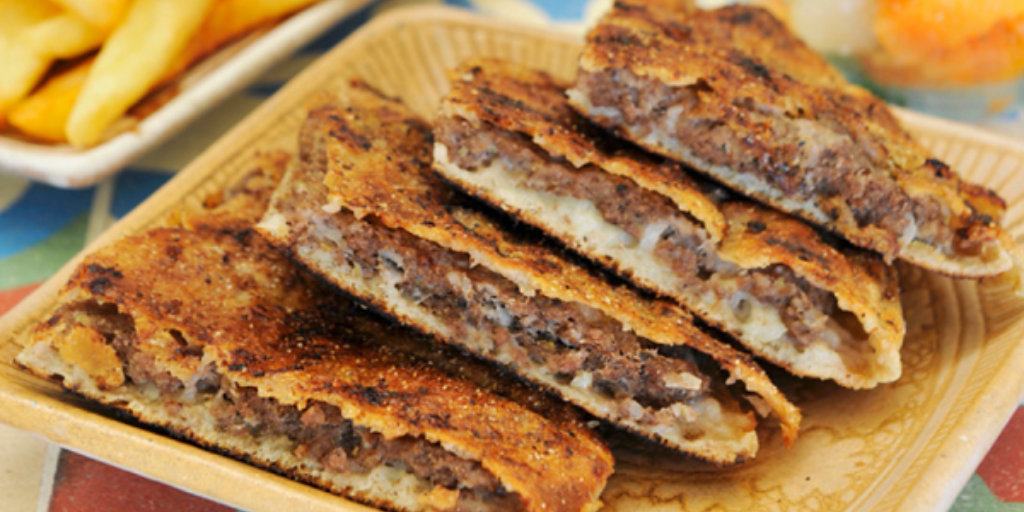Was he simply making himself an impromptu snack, or was he intentionally experimenting with new flavors and textures?
We may never know what this Egyptian butcher had in mind when he first decided to put minced meat inside baladi bread. Known for its thin texture, this type of bread is, after all, better suited for use as wedn otta (cat ears) for molokheya or for embracing the fatty goodness of Egyptian roomi (romano) cheese – but to sandwich meat? It was, most probably, completely unheard of at that point.
Regardless of his intentions, the combination of ingredients ended up becoming a winner; for he had no idea how this deceptively simple concoction – now called hawawshi – would turn into an eternal legacy in the Cairo streets he called home.
Confirming his exact name is a difficult feat; some argue it was Mohamed El-Hawawshi, while other accounts believe it was Ahmed El-Hawawsh. While many sources also claim that the meat-filled creation only dates back to the 1970s, it arguably goes back to the 1930s, as evidenced by a photo of an old butchery receipt claimed to be from his shop.

Hawawshi, often referred to as the “Egyptian burger,” is a meal close to the hearts of many Egyptians and one of the things they miss the most when living abroad – so much so that one young Egyptian took it upon himself to bring it to the Los Angeles palate.
The strong feelings Egyptians have for hawawshi are warranted; whether prepared in the oven or on the grill, it offers an array of different flavors in each bite, and the thin texture of baladi bread helps accentuate the taste of the meat to make it the hero of the meal.
Traditionally served with teheena (tahini) and torshi (pickles), today, hawawshi can be found all around Egypt’s different governorates. Rarely can Egyptians agree on who offers the best hawawshi, but they can all unite in thanking the innovative butcher who introduced it to Egyptian cuisine.
If you aren’t in Egypt, getting your hands on hawawshi might be a difficult endeavor. Luckily, The Matbakh’s recipe can help you get closer to reaching that authentic taste – just don’t forget to thank the mastermind behind it!

Hawawshi Recipe by The Matbakh:
Ingredients:
· 0.5 kilograms of ground beef meat
· 0.5 kilograms of ground lamb meat
· 10 loaves of baladi bread
· 3 small or 2 mediums onions
· 1 tomato
· 4 garlic cloves
· 1 bunch fresh mint
· 1 bunch fresh parsley
· 2 bell peppers
· 1 spicy pepper
· 1 tbsp tomato paste
· juice from a whole large lemon
· 2 tbsp cumin
· 1tbsp ground coriander
· salt and pepper to taste
Steps:
1. Heat oven to 400 ℉ (205 ℃).
2. Peel and chop onions into very small pieces. Chop tomato, bell pepper, and spicy pepper into very small pieces.
3. Chop mint and parsley leaves into very fine pieces.
4. Crush the garlic cloves and add salt.
5. Add onions, crushed garlic, tomato, bell pepper, fresh mint, fresh parsley, spicy pepper, cumin, coriander, salt, and black pepper to a large bowl. Add lemon juice and tomato paste.
6. Add ground meat to the bowl with the chopped veggies. Mix all of the ingredients together with your hands.
7. Cut baladi bread into two halves.
8. Stuff meat mixture into the baladi bread. Do not add too much meat; include just enough for a thin layer inside.
9. On a baking tray, add a layer of parchment paper.
10. Place bread pieces onto the cookie sheet pan with the thicker side of the bread facing down. Baladi bread has a thin side and a thick side, the thin side should face upwards.
11. Wet hands and rub the outside of the bread.
12. Using a pastry brush, spread a little olive oil on top of the sandwich (optional).
13. Roast in the oven for about 20 minutes. Remove when the top is golden brown (don’t flip the bread over).
14. If the bread is cooking too quickly, remove and pat the top of the bread with water and reduce the heat in the oven to 375 ℉ (190 ℃).
15. Remove from the baking tray and serve hot alongside tahini and pickles.
Subscribe to the Egyptian Streets’ weekly newsletter! Catch up on the latest news, arts & culture headlines, exclusive features and more stories that matter, delivered straight to your inbox by clicking here.






Comments (2)
[…] claim that they were invented in Cairo in the early 1970s by an Egyptian butcher either named Mohamed al-Hawawshi or Ahmed el-Hawawsh. However, Travel Food Atlas points out that hawash may also be a word for […]
[…] Hawawshi: […]